I am currently learning about Bode plots and transfer functions. I am confused about what information the "magnitude" values of the transfer function are supposed to contain. I am mainly confused about why the magnitude can be negative. Is this a convention to aid in calculations?
-
Does this answer your question? https://electronics.stackexchange.com/questions/53886/what-does-it-mean-for-a-signal-to-have-an-amplitude-below-0-db/53909#53909 – Lars Hankeln Dec 17 '22 at 22:30
-
Does this answer your question? [What does it mean for a signal to have an amplitude below 0 dB?](https://electronics.stackexchange.com/questions/53886/what-does-it-mean-for-a-signal-to-have-an-amplitude-below-0-db) – Marcus Müller Dec 17 '22 at 22:42
-
Do you mean how can decibels be negative? – Andy aka Dec 17 '22 at 22:42
2 Answers
The magnitude is just the length of the space diagonal of an n-dimensional right rectangular prism. In two dimensions this is often just called the diagonal of a right rectangle or else the hypotenuse. And it is always a positive real number, as you say. (Never really zero, though it can approach it arbitrarily closely.)
However, such numbers can also be expressed as logarithms, instead. An advantage gained by expressing positive numbers as logarithms is that multiplication of two positive real numbers can be performed by the addition of their equivalent logarithms, instead. (This fact was used on slide-rules, whose use has since fallen by the way because of the advent of computing machines.) Another advantage is that one can more quickly get an idea of the order of magnitude of \$C\$ and the dominance of \$A\$ vs \$B\$ by just a simple glance.
Suppose you want to multiply two numbers, \$A\$ and \$B\$, so that you have to find \$C\$ where \$C=A\cdot B\$. You could instead use \$a=\log_{10}\left(A\right)\$ and \$b=\log_{10}\left(B\right)\$, sum the two to get \$c=a+b\$, and then find that \$C=10^c\$.
In short, you can say that \$C=A\cdot B=10^{^{\log_{10}\left(A\right)}}\cdot 10^{^{\log_{10}\left(A\right)}}=10^{^{\log_{10}\left(A\right)\:+\:\log_{10}\left(B\right)}}\$.
But this is really just the same thing as saying \$c=a+b\$.
When you are doing a lot of multiplication (and division), using logarithms helps a lot.
The only issue is that now positive numbers that are less than 1 -- but still positive -- will be represented by negative values when turned into logarithms. That's just a quality of logarithms.
2 is larger than 1 so its logarithm will be positive. For example, \$\log_{10}\left(2\right)\approx +0.30103\$. But 0.5 is smaller than 1 so its logarithm will be negative. For example, \$\log_{10}\left(0.5\right)\approx -0.30103\$. Note that if I wanted to multiply \$2\times\frac12=1\$ this is the same thing as addition of their logarithms, \$+0.30103-0.30103=0\$, noting though that to get the final answer you perform \$10^0=1\$ (so 1 is the answer.)
With logarithms, a negative number is similar to division. So if you already know that \$+0.30103\$ is the logarithm of 2 then if you notice the addition of a logarithm of \$-0.30103\$, then you know this means the same thing as division by 2. (Even though you are adding it.)
Amplification multiplies and attenuation divides. Or you could say that amplification occurs when multiplying by a value larger than 1 (logarithm is positive) and that attenuation occurs when multiplying by a value less than 1 (logarithm is negative.) And you immediately know which is happening by just looking at the sign. So it's often convenient to use logarithms in electronics.
The only trick in electronics is that there are two common contexts -- power and voltage. For power, you multiply the logarithm by 10 and for voltage you multiply the logarithm by 20. So in the context of power you'd say an amplifier that doubles the power is the same thing as \$+3\:\text{dB}\$. Or doubling the voltage is the same thing as \$+6\:\text{dB}\$. (A few minor decimal points were tossed out.) It's a lot easier to talk about amplification and attenuation that way. (The downside is that you have to keep the 10x or 20x factor in mind.)
- 77,059
- 6
- 73
- 185
-
passing note re slide rules, you might be interested in the European Logarithmic Microprocessor project (ELM) and successors which does away with floating point and uses logarithmic arithmetic, showing speed and accuracy benefits. Interesting to have a processor which can divide in a clock cycle but need lookup tables and magic to add! – Dannie Dec 18 '22 at 01:13
Usually Bode plots depict magnitude in dB. Negative dB means that the signal is attenuated. Positive dB means that the signal is amplified. Zero dB means that the signal amplitude is unchanged.
Here is an example of a combination voltage divider low-pass filter that has negative gain at all frequencies:
I drew the schematic in LTSpice and used the built-in simulator to generate the Bode plot. This is just a screen capture of that effort.
- 28,915
- 1
- 28
- 81
